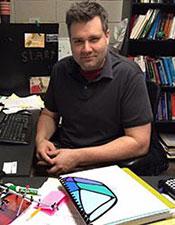Joseph Emerson
Classification
- Faculty
Discipline
- Biochemistry
- Inorganic
Research Summary
Bioinorganic chemistry, transition metal catalysis in biological systemsTitle
- Associate Professor
Contact
jemerson@chemistry.msstate.edu
662-325-9500
Address
- Hand Lab 1126
Bioinorganic chemistry, Biophysical chemistry, Enzymology, and Catalysis
Nearly half of all enzymes contain a metal ion that is required for stability and/or reactivity. Divalent metal ions can be found in each of the six enzymes classes, and more often than not these metal ions play distinctive roles in directing their chemistry. We are interested in how metal ions in biological systems impact their local protein environment and the roles they play in modulating structure and function. Our current research is focused on two main areas:
Metal Ion Coordination in Biological Systems
Nature uses a number of strategies to match metal ions with specific proteins, including sequestration and compartmentalization of metal ions in vivo. However, understanding the driving forces behind metal ion affinity and selectivity remains ambiguous. One focus of the Emerson laboratory is to unravel these issues using chemical, biochemical, and biophysical methods. Students in the Emerson group gain experience with modern biochemical methods and biophysical techniques such as isothermal titration and differential scanning calorimetry to study the dynamic changes associated with metal ion coordination chemistry in small molecule, peptide, protein, and nucleic acid based systems.
Bioinspired Catalysis
Transition metal catalysts are widely used for organic transformations. The Emerson lab is interested in designing new (bioinspired) catalysts and catalytic conditions for a number of transition metal catalyzed processes, including N and O atom transfer reactions and kinetic resolutions. Students working in this area use both organic and inorganic chemistry techniques to synthesize, characterize, and assess new metal-based catalytic systems.
Positions Open
We are always looking for quality graduate and undergraduate researchers to join our research group. Graduate students interested in joining the lab should have a strong background in biochemistry, inorganic, and physical chemistry. For undergraduates, advanced coursework is not required provided you possess enthusiasm and interest in biophysics research. Motivated freshmen and sophomores are encouraged to inquire about open position.
References
1. ITC methods for Assessing Buffer/Protein Interactions using Steady-State Kinetics: A reactivity study of Homoprotocatechuate 2,3-Dioxygenase Kate L. Henderson, Delta K. Boyles, Vu H. Le, Edwin A. Lewis, and Joseph P. Emerson. Methods in Enzymology 2016 567:257-78.
2. ITC investigations of the binding of metallated porphyrins to G-quadruplex DNA. Jesse I DuPont, Kate L Henderson, Amanda Metz, Vu H Le, Joseph P Emerson, Edwin A. Lewis. Biochimica Biophysica Acta 2015 1860(5):902-9
3. Thermodynamics of Substrate Binding to the Metal Site in Homoprotocatechuate 2,3-Dioxygenase: Using ITC under anaerobic conditions to study enzyme-substrate interactions. Kate L. Henderson, Danielle H. Francis, Edwin A. Lewis, Joseph P. Emerson. Biochimica Biophysica Acta, 2015 1860(5):910-6
4. Characterization of the Copper(II) Binding Sites in Human Carbonic Anhydrase II. Whitnee L. Nettles, He Song, Nicholas C. Fitzkee, Joseph P. Emerson, Inorganic Chemistry, 2015 54(12): 2278-2283.
5. Iodide-Induced Organothiol Desorption and Photochemical Reaction, Gold Nanoparticle (AuNP) Fusion, and SERS Signal Reduction in Organothiol-Containing AuNP Aggregates. Ganganath S. Perera, Allen LaCour, Yadong Zhou, Kate L. Henderson, Shengli Zou, Felio Perez, Joseph P. Emerson, Dongmao Zhang. Journal of Physical Chemistry C, 2015 1119(8): 4261-4267.
6. Calorimetric Assessment of Fe2+ Binding to α-Ketoglutarate/Taurine Dioxygenase: Ironing Out the Energetics of Metal Coordination by the 2-His-1-Carboxylate Facial Triad. Kate L. Henderson, Tina Müller, Robert Hausinger, Joseph P. Emerson. Inorganic Chemistry, 2015 54(5): 2278-2283.
7. Building reactive copper centers in human carbonic anhydrase II. He Song, Andrew C. Weirtz, Michael P. Hendrich, Edwin A. Lewis, Joseph P. Emerson. Journal of Biological Inorganic Chemistry, 2013 18(6): 595-598.
8. Revisiting Zinc Binding in Human Carbonic Anhydrase. He Song, David L. Wilson, Erik R. Farquhar, Edwin A. Lewis, Joseph P. Emerson. Inorganic Chemistry, 2012 51(20): 11098-105.
9. Exploring Substrate Binding in Homoprotocatechuate 2,3-Dioxygenase using Isothermal Titration Calorimetry. Kate L. Henderson, Vu H. Le, Edwin A. Lewis, Joseph P Emerson. Journal of Biological Inorganic Chemistry, 2012 17(7):991-4.
